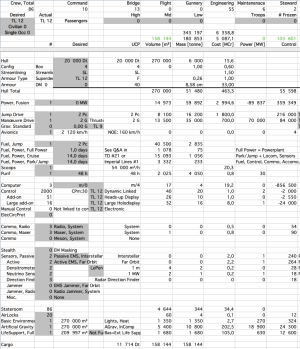AnotherDilbert
SOC-14 5K
There is no mass for LBB5 ships, only volume.So, I reworked my old 20,000-ton hauler (with the 13,650 d-ton hold) with the 10-tons per d-ton assumption for all the non-fuel bits, and ran the numbers to see what I could get in the cargo bay while keeping the overall ship to 200,000 mass-tons.
A PP-1 at TL-15 is 200 Dt = 2800 m³, mass unknown.
A 10 000 Dt cargo hold is 140 000 m³, mass unknown.
If we peek ahead at MT we do get masses specified for different components, but mass isn't really used, except for vehicles.
Something like this (MT uses 1 Dt = 13.5 m³):
A 20 000 Dt J-2, M-2 freighter, with a volume of 270 000 m³, empty mass of ~180 000 tonnes, loaded mass of ~343 000 tonnes

Note that the drives are still calculated as percentages of volume.
